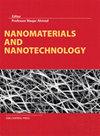湿度传感用锰掺杂氧化镍纳米片阵列薄膜结构、光学和电学特性的退火温度依赖性
IF 3.3
3区 材料科学
Q2 MATERIALS SCIENCE, MULTIDISCIPLINARY
引用次数: 9
摘要
采用浸渍法制备了掺杂锰的氧化镍纳米片阵列薄膜。将300°C至500°C之间的不同退火温度应用于锰掺杂的氧化镍纳米片阵列膜,以研究其对氧化镍性能的影响,包括湿度传感性能。场发射扫描电子显微镜(FESEM)、能量色散X射线光谱(EDS)、X射线衍射(XRD)、紫外-可见光(UV–vis)分光光度法、双探针电流-电压(I-V)测量系统和湿度测量系统用于表征热处理的掺锰氧化镍样品。对于不同的表面形貌和衍射图案,可以清楚地观察到退火温度的影响。随着退火温度的升高,样品的平均晶粒尺寸增加了0.63–10.13 nm。根据XRD数据还确定了位错密度、晶面间距、晶格参数、晶胞体积和应力/应变。所有样品在可见光区域的平均透射率显示出较低的百分比,在500°C下退火的掺锰氧化镍的最高透明度为50.7%。随着退火温度的升高,光学带隙呈现出减小的趋势。I-V测量结果表明,随着退火温度的升高,掺锰氧化镍的电导率值有所提高。湿度传感器的灵敏度显示出随温度升高而上升的曲线。在500°C下退火可获得最佳器件性能,最高灵敏度为270,响应和恢复时间最快。相反,在300°C下退火的样品显示出较差的传感性能。本文章由计算机程序翻译,如有差异,请以英文原文为准。
Annealing temperature dependency of structural, optical and electrical characteristics of manganese-doped nickel oxide nanosheet array films for humidity sensing applications
Manganese-doped nickel oxide nanosheet array films are successfully prepared on a nickel oxide seed-coated glass substrate by an immersion method. Various annealing temperatures between 300°C and 500°C are applied to the manganese-doped nickel oxide nanosheet array films to study their effect on the properties of nickel oxide, including humidity sensing performance. Field emission scanning electron microscopy (FESEM), energy dispersive X-ray spectroscopy (EDS), X-ray diffraction (XRD), ultraviolet–visible (UV–vis) spectrophotometry, a two-probe current–voltage (I-V) measurement system and a humidity measurement system are used to characterise the heat-treated manganese-doped nickel oxide samples. The effect of annealing temperature can be clearly observed for the different surface morphologies and diffraction patterns. The samples exhibit average crystallite size increases of 0.63–10.13 nm with increasing annealing temperature. The dislocation density, interplanar spacing, lattice parameter, unit cell volume and stress/strain are also determined from the XRD data. The average transmittances in the visible region for all samples show low percentages with the highest transparency of 50.7% recorded for manganese-doped nickel oxide annealed at 500°C. The optical band gap shows a decreasing trend with increasing annealing temperature. The I-V measurement results reveal that manganese-doped nickel oxide displays improved conductivity values with increasing annealing temperature. The sensitivity of the humidity sensors shows an ascending curve with increasing temperature. The optimal device performance is obtained with annealing at 500°C, with the highest sensitivity of 270 and the fastest response and recovery times. In contrast, the sample for annealing at 300°C shows poor sensing performance.
求助全文
通过发布文献求助,成功后即可免费获取论文全文。
去求助
来源期刊

Nanomaterials and Nanotechnology
NANOSCIENCE & NANOTECHNOLOGY-MATERIALS SCIENCE, MULTIDISCIPLINARY
CiteScore
7.20
自引率
21.60%
发文量
13
审稿时长
15 weeks
期刊介绍:
Nanomaterials and Nanotechnology is a JCR ranked, peer-reviewed open access journal addressed to a cross-disciplinary readership including scientists, researchers and professionals in both academia and industry with an interest in nanoscience and nanotechnology. The scope comprises (but is not limited to) the fundamental aspects and applications of nanoscience and nanotechnology
 求助内容:
求助内容: 应助结果提醒方式:
应助结果提醒方式:


